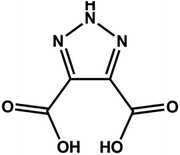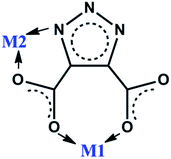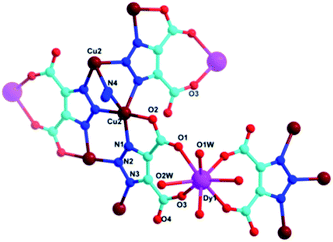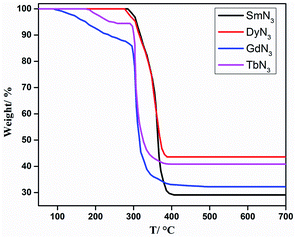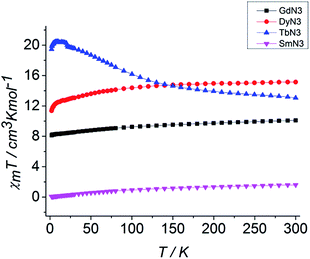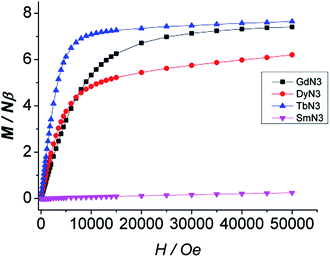LnIII ion dependent magnetism in heterometallic Cu–Ln complexes based on an azido group and 1,2,3-triazole-4,5-dicarboxylate as co-ligands†
Xue Jiang,
Song-De Han,
Ran Zhao,
Jian Xu* and
Xian-He Bu
Department of Chemistry, TKL of Metal- and Molecule-Based Material Chemistry and Collaborative Innovation Center of Chemical Science and Engineering (Tianjin), Nankai University, Tianjin 300071, P. R. China. E-mail: jxu@nankai.edu.cn
First published on 14th July 2015
Abstract
Four Cu–Ln coordination polymers [Cu2Ln(tda)2N3(H2O)4·2H2O] (Ln = Gd (1), Tb (2), Dy (3), Sm (4), tda = 1,2,3-triazole-4,5-dicarboxylate) have been synthesized by employing H3tda and azido as co-ligands. Complexes 1–4 exhibit the hydrogen bonded three-dimensional (3D) network and intriguing magnetic properties. Among them, 1, 3 and 4 involve antiferromagnetic interaction between metal ions, while 2 exhibits ferromagnetic behavior, demonstrating that magnetic properties could be mediated by a variety of rare earth metal ions.
Introduction
Molecule-based magnets have attracted considerable attention over the past decades, due to their unique properties and potential applications in high-density data storage technologies, quantum computing and molecular spintronics.1–5 Thus, many efforts have been devoted to this active field. Among various types of molecule-based magnets, a family of 3d–4f heterometallic coordination complexes are of great interest, since the incorporation of lanthanide and transition metal ions always leads to versatile properties.6–9 However, on the other hand, due to the competitive coordination between 3d and 4f ions to the same ligand, which favors to form homometallic rather than heterometallic coordination complexes, the synthesis of 3d–4f heterometallic magnets is still challenging. To address this issue, one promising way is to employ the polydentate ligands that allow the coordination with both lanthanide and transition metal ions simultaneously, bearing in mind that the lanthanide ions are oxyphile, while the transition metal ions preferentially coordinate with nitrogen atoms.On the other hand, azido has proved to be a promising and versatile bridging ligand, as it can readily coordinate to two or more metal ions, thus offering effective superexchange pathways for magnetic couplings among spin carriers.10 Furthermore, azido has a strong trend to coordinate with transition metals, according to hard–soft acid–base (HSAB) theory,11 thus giving rise to many intriguing structures with excellent magnetic properties.12 Besides that, azido can also provide E–E and/or E–O bridging mode and thereby has a capability of mediating the ferromagnetic or antiferromagnetic magnetic coupling between metal ions.
Based on above considerations, imidazolecarboxylate containing both N and O coordination sites has been elected here as main ligand, together with azido as co-ligand, to fabricate new 3d–4f magnets.13,14 Among a class of polydentate ligands, H3tda (tda = 1,2,3-triazole-4,5-dicarboxylate) should be a good candidate, because it involves both tri-N-donor and two carboxylate and thus can provide distinct coordination sites for 3d and 4f metal ions (Scheme 1). However, only a few 3d–4f coordination polymers based on H3tda has been documented hitherto.15,16 During the past decade, our group has devoted to fabricating the azido and carboxylate-mediated magnetic complexes,17 which would be helpful for research in this context (Scheme 2). By employing H3tda and azido as co-ligands, we herein report the syntheses of four new isostructural 3d–4f coordination complexes with three-dimensional (3D) structures, [LnCu2(tda)2(N3) (H2O)4·2H2O] (Ln = Gd (1), Ln = Tb (2), Ln = Dy (3), Ln = Sm (4)), together with a comprehensive study of their magnetic properties.
Experimental
Materials and physical measurements
The H3tda ligand was synthesized according to the reported method.18 All the chemicals used for synthesis are of analytical grade and commercially available. Cu(NO3)2·3H2O, Ln(NO3)3·6H2O and sodium azido were purchased from commercial sources and used as received.Caution: azido metal complexes are potentially explosive, only a small amount of material should be prepared with care.
Elemental analyses (C, H, N) were performed on a Perkin-Elmer 240C analyzer. The X-ray powder diffraction (XRPD) was recorded on a Rigaku D/Max-2500 diffractometer at 40 kV, 100 mA for a Cu-target tube and a graphite monochromator. Simulation of the XRPD spectra was carried out by the single-crystal data and diffraction-crystal module of the mercury (Hg) program available free of charge via the internet at http://www.iucr.org.
The thermal gravimetric analyses (TGA) was performed with a TGA Q500 instrument under N2 from room temperature to 700 °C with a heating rate of 10 °C min−1 using aluminium crucibles.
IR spectra were measured in the range of 400–4000 cm−1 on a Tensor 27 OPUS FT-IR spectrometer using KBr pellets (Bruker, German).
Magnetic data were collected using crushed crystals of the sample on a Quantum Design MPMS-XL SQUID magnetometer equipped with a 7T magnet. The data were corrected using Pascal's constants to calculate the diamagnetic susceptibility; an experimental correction for the sample holder was applied.
General synthetic procedure for [LnCu2(tda)2N3(H2O)4]·2H2O, LnIII = Gd, Tb, Dy, Sm: a water solution of CuNO3·3H2O, LnNO3·6H2O (Ln = Gd for 1, Tb for 2 and Dy for 3, Sm for 4), H3tda and NaN3 with the ratio 2![[thin space (1/6-em)]](https://www.rsc.org/images/entities/char_2009.gif) :
:![[thin space (1/6-em)]](https://www.rsc.org/images/entities/char_2009.gif) 1
1![[thin space (1/6-em)]](https://www.rsc.org/images/entities/char_2009.gif) :
:![[thin space (1/6-em)]](https://www.rsc.org/images/entities/char_2009.gif) 1
1![[thin space (1/6-em)]](https://www.rsc.org/images/entities/char_2009.gif) :
:![[thin space (1/6-em)]](https://www.rsc.org/images/entities/char_2009.gif) 1 were sealed in a Teflon-lined autoclave and heated to 140 °C. After maintained for 48 h, the reaction vessel was cooled to room temperature in 12 h, dark green crystals were collected with ca. 12% yields based on CuCl2·2H2O. FT-IR (KBr pellets, cm−1): for 1: 3421(s), 2358(m),1624(vs), 1541(s), 1436(m), 1388(s), 1315(m), 1156(s), 873(m), 828(s), 790(m); for 2: 3412(s), 2360(m), 1625(vs), 1541(s), 1434(m), 1389(s), 1303(m), 1151(s), 878(m), 831(s), 787(m); for 3: 3410(s), 2358(m), 1627(vs), 1540(s), 1432(m), 1391(s), 1311(m), 1154(s), 873(m), 829(s), 788(m); for 4: 3419(s), 1623(vs), 1624(s), 1432(m), 1392(s), 1308(m), 1154(s), 878(m), 829(s), 788(m); Elemental analytical data correspond to: C8H12Cu2N9O14Gd (1) calcd: C, 12.91; H, 1.60; N, 16.95%. Found: C, 13.21; H, 1.78; N, 17.65%. C8H12Cu2N9O14Tb (2) calcd: C, 12.89; H, 1.61; N, 16.91%. Found: C, 13.35; H, 1.82; N, 17.68%. C8H12Cu2N9O14Dy (3) calcd: C, 12.82; H, 1.60; N, 16.83%. Found: C, 13.18; H, 1.75; N, 17.35%. C8H12Cu2N9O14Sm (4) calcd: C, 13.03; H, 1.63; N, 17.11%. Found: C, 13.25; H, 1.75; N, 18.24%.
1 were sealed in a Teflon-lined autoclave and heated to 140 °C. After maintained for 48 h, the reaction vessel was cooled to room temperature in 12 h, dark green crystals were collected with ca. 12% yields based on CuCl2·2H2O. FT-IR (KBr pellets, cm−1): for 1: 3421(s), 2358(m),1624(vs), 1541(s), 1436(m), 1388(s), 1315(m), 1156(s), 873(m), 828(s), 790(m); for 2: 3412(s), 2360(m), 1625(vs), 1541(s), 1434(m), 1389(s), 1303(m), 1151(s), 878(m), 831(s), 787(m); for 3: 3410(s), 2358(m), 1627(vs), 1540(s), 1432(m), 1391(s), 1311(m), 1154(s), 873(m), 829(s), 788(m); for 4: 3419(s), 1623(vs), 1624(s), 1432(m), 1392(s), 1308(m), 1154(s), 878(m), 829(s), 788(m); Elemental analytical data correspond to: C8H12Cu2N9O14Gd (1) calcd: C, 12.91; H, 1.60; N, 16.95%. Found: C, 13.21; H, 1.78; N, 17.65%. C8H12Cu2N9O14Tb (2) calcd: C, 12.89; H, 1.61; N, 16.91%. Found: C, 13.35; H, 1.82; N, 17.68%. C8H12Cu2N9O14Dy (3) calcd: C, 12.82; H, 1.60; N, 16.83%. Found: C, 13.18; H, 1.75; N, 17.35%. C8H12Cu2N9O14Sm (4) calcd: C, 13.03; H, 1.63; N, 17.11%. Found: C, 13.25; H, 1.75; N, 18.24%.
X-ray data collection and structure determinations
X-ray single-crystal diffraction data for complexes 1–4 were collected on a Rigaku SCX-mini diffractometer at 293(2) K with Mo-Kα radiation (λ = 0.71073 Å) by ω scan mode. The program CrystClear19 was used for integration of the diffraction profiles. All the structures were solved by direct methods using the SHELXS program of the SHELXTL package and refined by full-matrix least-squares methods with SHELXL (semi-empirical absorption corrections were applied using SADABS program).20 Metal atoms in each complex were located from the E-maps and other non-hydrogen atoms were located in successive difference Fourier syntheses and refined with anisotropic thermal parameters on F2. The hydrogen atoms of the ligands were generated theoretically onto the specific atoms and refined isotropically with fixed thermal factors. Table 1 shows crystallographic crystal data and structure processing parameters. Selected bond lengths and bond angles are listed in Table 2.| 1-Gd | 2-Tb | 3-Dy | 4-Sm | |
|---|---|---|---|---|
| a R = Σ||Fo| − |Fc||/Σ|Fo|.b Rw = [Σ[w(Fo2 − Fc2)2]/Σw(Fo2)2]1/2. | ||||
| Chemical formula | C8H12Cu2N9O14Gd | C8H12Cu2N9O14Tb | C8H12Cu2N9O14Dy | C8H12Cu2N9O14Sm |
| Formula weight | 742.60 | 744.27 | 747.85 | 735.70 |
| Space group | P2/c | P2/c | P2/c | P2/c |
| a (Å) | 11.827(2) | 11.819(2) | 11.787(2) | 11.878(2) |
| b (Å) | 7.4867(15) | 7.3367(15) | 7.4590(15) | 7.4838(15) |
| c (Å) | 11.557(2) | 11.533(2) | 11.559(2) | 11.582(2) |
| β/deg | 103.03(3) | 103.19 | 103.14(3) | 103.09(3) |
| V/Å3 | 997.0(3) | 973.7(3) | 989.7(3) | 1002.8(3) |
| Z | 2 | 2 | 2 | 2 |
| GOF | 1.140 | 1.058 | 1.177 | 1.336 |
| D/g cm−3 | 2.510 | 2.539 | 2.436 | 2.474 |
| μ/mm−1 | 5.495 | 5.852 | 5.960 | 5.084 |
| T/K | 293 | 293 | 293 | 293 |
| Ra/wRb (I > 2σ(I) | 0.0447/0.0686 | 0.0634/0.1344 | 0.0549/0.1221 | 0.0476/0.1052 |
| R1/wR2 (for all data) | 0.0573/0.0715 | 0.0801/0.1430 | 0.0596/0.1244 | 0.0523/0.1066 |
| 1-Gd | 2-Tb | 3-Dy | 4-Sm | |
|---|---|---|---|---|
| a Symmetry codes: (#1) x, y, z; (#2) y, x, z; (#3) y, x, z; (#4) x, y, z; (#5) y, x, z; (#6) x, y1, z; (#7) x, y1, z. | ||||
| Ln–O(3) | 2.273(4) | 2.244(8) | 2.261(7) | 2.311(7) |
| Ln–O(3)#3 | 2.273(4) | 2.244(8) | 2.261(7) | 2.311(7) |
| Ln–O(1W)#3 | 2.384(5) | 2.344(7) | 2.368(7) | 2.419(6) |
| Ln–O(1W) | 2.384(5) | 2.344(7) | 2.368(7) | 2.419(6) |
| Ln–O(1) | 2.452(4) | 2.428(7) | 2.431(7) | 2.467(6) |
| Ln–O(1)#3 | 2.452(4) | 2.428(7) | 2.431(7) | 2.467(6) |
| Ln–O(2W)#3 | 2.456(5) | 2.437(8) | 2.449(5) | 2.488(4) |
| Ln–O(2W) | 2.456(5) | 2.437(8) | 2.449(5) | 2.488(4) |
| Cu(2)–N(1) | 1.954(4) | 1.952(9) | 1.954(9) | 1.963(7) |
| Cu(2)–O(2) | 1.973(4) | 1.954(8) | 1.972(7) | 1.972(6) |
| Cu(2)–N(2)#2 | 1.980(4) | 1.969(9) | 1.979(8) | 1.973(7) |
| Cu(2)–N(4) | 2.103(4) | 2.196(13) | 2.116(5) | 2.102(4) |
| Cu(2)–N(3)#4 | 2.183(4) | 2.136(9) | 2.170(8) | 2.191(7) |
| N(3)–Cu(2)#1 | 2.183(4) | 2.136(9) | 2.170(8) | 2.191(7) |
| N(2)–Cu(2)#2 | 1.980(4) | 1.969(9) | 1.979(8) | 1.973(7) |
| N(4)–Cu(2)#5 | 2.103(4) | 2.196(13) | 2.116(5) | 2.102(4) |
| Cu(2)–N(4)–Cu(2)#5 | 105.0(3) | 99.5(8) | 104.5(2) | 105.45(19) |
Results and discussion
Description of crystal structure
Complexes 1–4 are essentially isostructural and crystallize in the monoclinic P2/c space group confirmed by their very similar PXRD patterns and also the single crystal structural analysis (Table 1). Therefore, we will only describe the structure of 3 as a representation for clarity. As shown in Fig. 1, the asymmetric unit of 3 contains half DyIII ion, one CuII ions, half azido anion, one tda3− anion, and two coordinating as well as one non-coordinating water molecule. Each CuII ion is pentacoordinated with three nitrogen atoms from three individual tda3− anions, one carboxyl oxygen atom and one azido anion. In forming a one-dimensional (1D) copper chain, the involved CuII ions connect to each other by sharing a common side (Fig. 2a), where the azido anions interconnect diagonal copper ions in E–O mode that could further stable this chain structure. On the other hand, each DyIII anion is coordinated by four carboxyl oxygen atoms from the tda3− ligands of the copper chain, which tends to link two adjacent copper chains to form a two-dimensional (2D) 3d–4f coordination network (Fig. 2b). In the resulting 2D complex, hydrogen bond interaction plays a vital role in consolidating the crystalline structure. As shown in Fig. 2c, the twisted layers are interconnected together via hydrogen bonds to produce a 3D supramolecular network. Moreover, each LnIII ion exhibits a square antiprism configuration, which is coordinated by four carboxyl oxygen atoms of two tda3− ligands and four water molecules (Fig. 2a), with the distances of Gd–O bonds ranging from 2.273(4) to 2.456(5) Å (Table 1) and the O–Gd–O angles in the range of 70.61(19)–145.64(18)° (Table 2).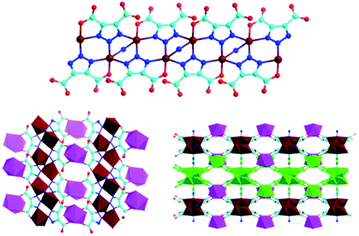 | ||
| Fig. 2 (a) The 1D chain connected by azido in 3. (b) A 2D LnIII coordinated 3d–4f network. (c) 3D supramolecular network connected by hydrogen bonds. | ||
PXRD patterns and thermal stabilities
PXRD measurements were carried out at room temperature to confirm their crystalline phase purities. The diffraction peaks of bulk samples are consistent with the simulated patterns based on the single crystal data, thus indicating the presence of mainly one crystalline phase in the corresponding samples of 1–4 (Fig. 3). To examine their thermal stabilities, TGA was performed under N2 atmosphere. The TGA results of 1 and 2 are quite similar, both showing a two-step weight loss before 300 °C (Fig. 4). In detail, the weight loss quantity during the first step (90–300 °C) is 3.77% for 1 and 4.51% for 2, which agrees well with the calculated value when releasing two uncoordinated water molecules (calcd: 4.84% for 1; 4.83% for 2). Similar analyses also indicate that the second step is ascribed to the release of four coordinated water molecules (found: 9.13% for 1, 8.95% for 2; calcd: 9.68% for 1, 9.87% for 2). After that, further elevating the temperature above 300 °C then leads to the decomposition of these two complexes. On the other hand, the TGA plots of complexes 3 and 4 are also in a similar pattern, which indicate that no obvious weight loss occur between room temperature and 300 °C, as compared with those of complexes 1 and 2. Further heating also leads to the collapse of the frameworks, which occurs in accompany with the loss of coordinated water and free water molecules (Fig. 4).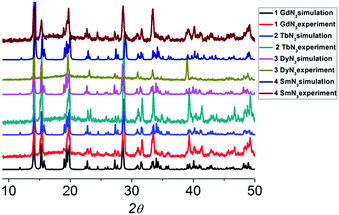 | ||
| Fig. 3 Comparisons of the experimental PXRD patterns of as-synthesized 1–4 with that simulated from single crystal data. | ||
Magnetic properties
The direct current (dc) magnetic susceptibilities of complexes 1–4 were measured in an applied magnetic field of 1000 Oe in the temperature range of 300–2 K. The profiles of χMT vs. T plots and M vs. H are shown in Fig. 5 and 6. For 1, the χMT value at room temperature is 10.09 cm3 K mol−1, little larger than the sum of one isolated GdIII and two CuII ions (8.63 cm3 K mol−1). With the decreasing temperature, the value of χMT slowly decreases from 10.09 cm3 K mol−1 at 300 K to 8.13 cm3 K mol−1 at 2 K. The Curie–Weiss fitting to the magnetic data between 2 K and 300 K gives the Weiss constant of θ = −4.49 K, which suggests an overall antiferromagnetic interaction in 1. Moreover, the plot of M vs. H reveals that the magnetization of 1 approaches to a maximum value 7.41 Nβ when H increases to 5 T at 2 K, which is slightly smaller than the theoretical saturation value, 9 Nβ, for a single GdIII (S = 7/2, g = 2) and two CuII ions (S = 1/2, g = 2).For 2, the observed χMT value of 13.06 cm3 K mol−1 at room temperature is close to the sum of one isolated TbIII and two CuII ions (12.57 cm3 K mol−1). Upon lowering the temperature, the value of χMT initially increases to 20.47 cm3 K mol−1 at 10 K and then gradually decreases to 19.47 cm3 K mol−1 at 2 K. The Curie–Weiss fitting of the magnetic data gives C = 12.29 cm3 K mol−1 and θ = 22.15 K, thus indicating that there exists a ferromagnetic coupling between the metal ions. The decline at low temperatures might be due to the magnetic saturation and/or zero-field splitting. The comparison with the reported complex {[Cu2Tb(tda)2Cl(H2O)4]·2H2O}n,16a which exhibits an antiferromagnetic behaviour, indicates that it is possible to realize a transformation from antiferromagnetic to ferromagnetic interaction by changing Cl− to N3−. According to literatures, ferromagnetic interactions usually occur between TbIII and CuII ions mediated by bridging ligands.21 Fig. 6 shows that for 2, the field-dependent magnetizations at 2 K abruptly increase at low fields (<1 T) and then steadily increase to a maximum value 7.65 Nβ, which is smaller than the theoretical saturation value of 11 Nβ for one TbIII (J = 6, g = 3/2) and two CuII ions (S = 1/2, g = 2).
The χMT value of complex 3 at room temperature is found to be 15.15 cm3 K mol−1, which is close to the sum of one isolated DyIII and two CuII ions (14.92 cm3 K mol−1) and thus also evidences a transformation from antiferromagnetic to ferromagnetic interaction by changing Cl− to N3−. With the temperature lowering, χMT decreases gradually from 15.15 cm3 K mol−1 at 300 K to 11.36 cm3 K mol−1 at 2 K, corresponding to a Weiss constant of θ = −3.64 K estimated from the Curie–Weiss fitting to the magnetic data. However, it is difficult to identify the magnetic interaction between the metal ions of 3, since the strong spin–orbit coupling of DyIII ions always leads to the thermotropic depopulation of the excited states. Further lowering the temperature will cause a decrease in χMT, which might be due to a selective depopulation of the excited crystal field state and/or antiferromagnetic interaction between LnIII and CuII ions. The magnetization of 3 features a steady increase with the increasing H and the experimental saturation value is found to be 6.20 Nβ at 5 T and 2 K, which is much smaller than the theoretical value of 12 Nβ for one individual DyIII (J = 15/2 and g = 4/3) and two CuII ions (S = 1/2, g = 2).
For 4, the χMT value observed at room temperature is 1.61 cm3 K mol−1, which is close to the sum of one isolated SmIII and two CuII ions (0.84 cm3 K mol−1). With the decreasing temperature, the value of χMT slowly decreases to 0.069 cm3 K mol−1 at 2 K. Strikingly, the Curie–Weiss fitting of the magnetic data gives the Weiss constant of θ = −176.96 K. This abnormal negative value of θ is much larger than that of complexes 1–3. This is mainly due to the coupling between spin and orbital magnetic moment that are coupled antiparallel by the spin–orbital interaction and almost cancel out each other.22 Furthermore, the plot of M vs. H does not follow the Brillouin curves. Instead, M rises with the increasing H. Evidently, the saturation value of 0.25 Nβ is much smaller than the theoretical value of 2.71 Nβ for one SmIII (J = 5/2, g = 2/7) ion and two CuII (S = 1/2, g = 2), thus indicating that there exist antiferromagnetic interactions along with spin competition in the system (frustration index, f = |θ|/TN = 177/2 = 88.5).
Conclusions
Four new 3d–4f heterometallic coordination polymers based on azido and N/O mixed-donor-bridging ligand 1,2,3-triazole-4,5-dicarboxylate have been successfully synthesized under hydrothermal condition. These isostructural heterometallic complexes exhibit unique 3D coordination networks and intriguing magnetic properties. While 1, 3 and 4 involves antiferromagnetic interactions, complex 2 exhibits a ferromagnetic behavior. These results thus indicate that the magnetic properties could be mediated by a variety of rare earth metal ions.Acknowledgements
This work was supported by the 973 Program of China (grant 2014CB845600), the NSF of China (grants 21421001, 21290171, and 21403116) and MOE Innovation Team (IRT13022) of China.Notes and references
- J. L. C. Rowsell and O. M. Yaghi, Angew. Chem., Int. Ed., 2005, 44, 4670 CrossRef CAS PubMed.
- (a) W.-X. Zhang, W. Xue, Y.-Z. Zheng and X.-M. Chen, Chem. Commun., 2009, 3804 RSC; (b) T.-F. Liu, D. Fu, S. Gao, Y.-Z. Zhang, H.-L. Sun, G. Su and Y.-J. Liu, J. Am. Chem. Soc., 2003, 125, 13976 CrossRef CAS PubMed.
- (a) O. Hatlevik, W. E. Buschmann, J. Zhang, J. L. Manson and J. S. Miller, Adv. Mater., 1999, 11, 914–918 CrossRef CAS; (b) D. Maspoch, D. Ruiz-Molina and J. Veciana, Chem. Soc. Rev., 2007, 36, 770 RSC.
- H. K. Chae, D. Y. Siberio-Perez, J. Kim, Y. Go, M. Eddaoudi, A. J. Matzger, M. O'Keeffe and O. M. Yaghi, Nature, 2004, 427, 523 CrossRef CAS PubMed.
- (a) D.-F. Weng, Z.-M. Wang and S. Gao, Chem. Soc. Rev., 2011, 40, 3157 RSC; (b) P. Zhang, L. Zhang, C. Wang, S.-F. Xue, S.-Y. Lin and J.-K. Tang, J. Am. Chem. Soc., 2014, 136, 4484 CrossRef CAS PubMed; (c) J. Ru, F. Gao, T. Wu, M.-X. Yao, Y.-Z. Li and J.-L. Zuo, Dalton Trans., 2014, 43, 933 RSC; (d) H. Zhang, G.-L. Zhuang, X.-J. Kong, Y.-P. Ren, L.-S. Long, R.-B. Huang and L.-S. Zheng, Cryst. Growth Des., 2013, 13, 2493 CrossRef CAS.
- (a) J. W. Sharples and D. Collison, Coord. Chem. Rev., 2014, 260, 1 CrossRef CAS PubMed; (b) F.-H. Zhao, H. Li, Y.-X. Che, J.-M. Zheng, V. Vieru, L. F. Chibotaru, F. Grandjean and G. J. Long, Inorg. Chem., 2014, 53, 9785 CrossRef CAS PubMed; (c) S.-D. Han, S.-J. Liu, Q.-L. Wang, X.-H. Miao, T.-L. Hu and X.-H. Bu, Cryst. Growth Des., 2015, 15, 2253 CrossRef CAS.
- (a) M. Murugesu, A. Mishra, W. Wernsdorfer, K. A. Abboud and G. Christou, Polyhedron, 2006, 25, 613 CrossRef CAS PubMed; (b) A. Deb, T. T. Boron III, M. Itou, Y. Sakurai, T. Mallah, V. L. Pecoraro and J. E. Penner-Hahn, J. Am. Chem. Soc., 2014, 136, 4889 CrossRef CAS PubMed; (c) J. W. Sharples and D. Collison, Coord. Chem. Rev., 2014, 260, 1 CrossRef CAS PubMed.
- (a) F.-S. Guo, Y.-C. Chen, J.-L. Liu, J.-D. Leng, Z.-S. Meng, P. Vrabel, M. Orendac and M.-L. Tong, Chem. Commun., 2012, 48, 12219 RSC; (b) J. Lin, P. Chai, K. Diefenbach, M. Shatruk and T. E. Albrecht-Schmitt, Chem. Mater., 2014, 26, 2187 CrossRef CAS; (c) K. S. Pedersen, G. Lorusso, J. J. Morales, T. Weyhermueller, S. Piligkos, S. K. Singh, D. Larsen, M. Schau-Magnussen, G. Rajaraman, M. Evangelisti and J. Bendix, Angew. Chem., Int. Ed., 2014, 53, 2394 CrossRef CAS PubMed.
- (a) P.-F. Shi, G. Xiong, B. Zhao, Z.-Y. Zhang and P. Cheng, Chem. Commun., 2013, 49, 2338 RSC; (b) S. K. Langley, D. P. Wielechowski, V. Vieru, N. F. Chilton, B. Moubaraki, L. F. Chibotaru and K. S. Murray, Chem. Sci., 2014, 5, 3246 RSC.
- (a) Y.-F. Zeng, X. Hu, F.-C. Liu and X.-H. Bu, Chem. Soc. Rev., 2009, 38, 469 RSC; (b) J.-P. Zhao, R. Zhao, Q. Yang, W.-C. Song, B.-W. Hu, X.-F. Zhang and X.-H. Bu, Dalton Trans., 2012, 41, 4852 RSC; (c) J.-P. Zhao, B.-W. Hu, Q. Yang, X.-F. Zhang, T.-L. Hu and X.-H. Bu, Dalton Trans., 2010, 39, 56 RSC; (d) J.-P. Zhao, B.-W. Hu, E. C. Sanudo, Q. Yang, Y.-F. Zeng and X.-H. Bu, Inorg. Chem., 2009, 48, 2482 CrossRef CAS PubMed; (e) F.-C. Liu, Y.-F. Zeng, J.-R. Li, X.-H. Bu, H.-J. Zhang and J. Ribas, Inorg. Chem., 2005, 44, 7298 CrossRef CAS PubMed; (f) A.-H. Fu, X.-Y. Huang, J. Li, T. Yuen and C.-L. Lin, Chem.–Eur. J., 2002, 8, 2239 CrossRef CAS; (g) S. D. Han, J. P. Zhao, S. J. Liu and X. H. Bu, Coord. Chem. Rev., 2015, 289–290, 32 CrossRef CAS PubMed.
- (a) R. G. Pearson, J. Am. Chem. Soc., 1963, 85, 3533 CrossRef CAS; (b) S. Naiya, S. Biswas, M. G. Drew, C. J. Gómez-García and A. Ghosh, Inorg. Chem., 2012, 51, 5332 CrossRef CAS PubMed.
- (a) C. Benelli and D. Gatteschi, Chem. Rev., 2002, 102, 2369 CrossRef CAS PubMed; (b) S.-S. Bao, K. Otsubo, J. M. Taylor, Z. Jiang, L.-M. Zheng and H. Kitagawa, J. Am. Chem. Soc., 2014, 136, 9292 CrossRef CAS PubMed; (c) L. B. L. Escobar, G. P. Guedes, S. Soriano, N. L. Speziali, A. K. Jordao, A. C. Cunha, V. F. Ferreira, C. Maxim, M. A. Novak, M. Andruh and M. G. F. Vaz, Inorg. Chem., 2014, 53, 7508 CrossRef CAS PubMed.
- (a) Y. Liu, J.-P. Zhao and N.-X. Li, Inorg. Chem. Commun., 2013, 29, 187 CrossRef CAS PubMed; (b) G.-F. Liu, Z.-G. Ren, Y. Chen, D. Liu, H.-X. Li, Y. Zhang and J.-P. Lang, Inorg. Chem. Commun., 2008, 11, 225 CrossRef CAS PubMed.
- (a) W.-X. Zhang, W. Xue and X.-M. Chen, Inorg. Chem., 2011, 50, 309 CrossRef CAS PubMed; (b) Y.-G. Sun, X. Gao, G. Xiong, W.-H. Zong, F. Ding, Z.-H. Xu, S.-J. Wang, L.-X. You, B.-Y. Ren and E.-J. Gao, Inorg. Chim. Acta, 2014, 409, 497 CrossRef CAS PubMed.
- (a) J.-Y. Zou, W. Shi, N. Xu, H.-L. Gao, J.-Z. Cui and P. Cheng, Eur. J. Inorg. Chem., 2014, 2014, 407 CrossRef CAS PubMed; (b) W.-X. Zhang, W. Xue, J.-B. Lin, Y.-Z. Zheng and X.-M. Chen, CrystEngComm, 2008, 10, 1770 RSC.
- (a) J.-Y. Zou, N. Xu, W. Shi, H.-L. Gao, J.-Z. Cui and P. Cheng, RSC Adv., 2013, 3, 21511 RSC; (b) T. Zhao, X. Jing, J. Wang, D. Wang, G. Li, Q. Huo and Y. Liu, Cryst. Growth Des., 2012, 12, 5456 CrossRef CAS.
- For example: (a) J.-P. Zhao, R. Zhao, W.-C. Song, Q. Yang, F.-C. Liu and X.-H. Bu, Cryst. Growth Des., 2013, 13, 437 CrossRef CAS; (b) Q. Yang, J.-P. Zhao, W.-C. Song and X.-H. Bu, Dalton Trans., 2012, 41, 6272 RSC; (c) B.-W. Hu, J.-P. Zhao, J. Tao, X.-J. Sun, Q. Yang, X.-F. Zhang and X.-H. Bu, Cryst. Growth Des., 2010, 10, 2829 CrossRef CAS; (d) Q. Yang, J.-P. Zhao, B.-W. Hu, X.-F. Zhang and X.-H. Bu, Inorg. Chem., 2010, 49, 3746 CrossRef CAS PubMed.
- L. E. Hinkel, G. O. Richards and O. Thomas, J. Chem. Soc., 1937, 1432 RSC.
- Rigaku, Process-Auto, Rigaku Americas Corporation, The Woodlands, Texas, 1998 Search PubMed.
- G. M. Sheldrick, SHELXL-97, Program for refinement of crystal structures, University of Göttingen, Germany, 1997 Search PubMed.
- (a) V. Chandrasekhar, T. Senapati, A. Dey, S. Das, M. Kalisz and R. Clerac, Inorg. Chem., 2012, 51, 2031 CrossRef CAS PubMed; (b) F. Z. Chiboub Fellah, J.-P. Costes, C. Duhayon, J.-C. Daran and J.-P. Tuchagues, Polyhedron, 2010, 29, 2111 CrossRef CAS PubMed; (c) G. Cosquer, F. Pointillart, Y. Le Gal, S. Golhen, O. Cador and L. Ouahab, Chem.–Eur. J., 2011, 17, 12502 CrossRef CAS PubMed; (d) B. Cristovao, J. Klak, B. Miroslaw and L. Mazur, Inorg. Chim. Acta, 2011, 378, 288 CrossRef CAS PubMed; (e) T. Shiga, H. Miyasaka, M. Yamashita, M. Morimoto and M. Irie, Dalton Trans., 2011, 40, 2275 RSC.
- H. Adachi and H. Ino, Nature, 1999, 401, 148 CrossRef.
Footnote |
| † CCDC 1061711 (1), 1061713 (2), 1061710 (3) and 1061712 (4) contain the supplementary crystallographic data for this paper. For crystallographic data in CIF or other electronic format see DOI: 10.1039/c5ra07972a |
| This journal is © The Royal Society of Chemistry 2015 |

